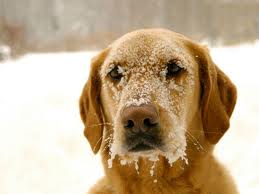Winter Pet Tips
27 Jan |
Posted by katherine |
1 comment |

 Tips For Keeping Your Pet Safe and Warm This Winter
Tips For Keeping Your Pet Safe and Warm This Winter
- Keep an eye on the temperature. When it falls below 20 degrees Fahrenheit, it’s best to keep your pet indoors. Short-haired dogs, cats and puppies should be kept indoors when the temperature dips below 40 degrees Fahrenheit.
- Compare the amount of exercise your dog receives during the colder months to warmer months. If your dog is indoors more at this time of year, it’s probably getting less exercise and may need less food. However, if your pet is outside often in the winter months, it may need more food to burn the calories necessary to produce more body heat
- Use a damp towel to wipe your pet’s feet and underside. Ice-melting chemicals can irritate and burn the pads of your pet’s feet and can cause serious injury if ingested. Another way to protect your dog’s feet is to spray the pads of their feet with cooking spray or you can purchase boots for your pet.
- Keep an eye on the temperature. When it falls below 20 degrees Fahrenheit, it’s best to keep your pet indoors. Short-haired dogs, cats and puppies should be kept indoors when the temperature dips below 40 degrees Fahrenheit.
- Keep your pet’s coat well groomed. Matted fur won’t properly protect your pet from the cold.
- Provide a dry, draft-free doghouse if you must keep your dog outside for any period of time. It should be large enough to allow your dog to sit and lay down comfortably but small enough to hold in its body heat. The floor should be raised a few inches off the ground and covered with cedar shavings or straw. The doghouse should be turned to face away from the wind, and the doorway should be covered with waterproof burlap or heavy plastic.
- Regularly check your pet’s water to make sure it’s not frozen. When your pet is outside, make sure there is plenty of fresh drinking water available. Animals can’t burn calories without a fresh supply of water, and if they can’t burn calories, they’ll get cold. Also, use a tip-resistant, ceramic or hard plastic water bowl rather than a metal one, as your pet’s tongue can stick and freeze to a cold metal.
- Check your garage and driveway for antifreeze. Antifreeze tastes sweet to pets, but most brands are poisonous if consumed. Should your pet ingest any amount of antifreeze, contact your veterinarian immediately.
§ Never leave pets alone in cars. When the engine is off, a car can act as a refrigerator, holding in the cold.
§ Pets can get frostbite too. Watch for red, gray or whitish areas on your dog’s nose, ears and feet. Also, watch out for “ice balls,” or balls of slushy snow that form between your dog’s toes. Keeping fur between the toes clipped is a good way to prevent this.
§ Please make sure your dog is licensed and has a current ID tag.
Information provided by www.ny1.com and the www.sspca.org.
Posted by
katherine
Originally from Ireland I have lived in Boston, MA since I was 6 years old. I have had a passion for animals my whole life and I feel very fortunate for the opportunity to work with them in my daily life at Kat’s Dog Walking

 Tips For Keeping Your Pet Safe and Warm This Winter
Tips For Keeping Your Pet Safe and Warm This Winter
1 comment
Ice
It’s important to try to keep your dog from eating snow, especially in the city, because that snow can contain chemicals from de-icers.Just like humans have body parts that are more prone to damage from the cold, so do our pets. Take care to make sure paws, tips of tails, ears, and noses are not getting too cold.
13 years ago |